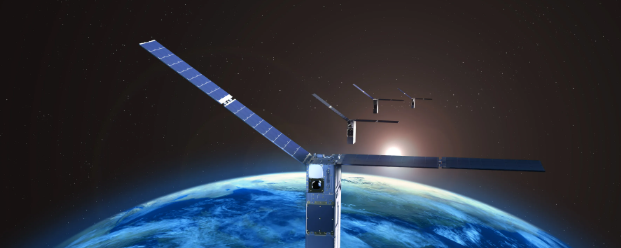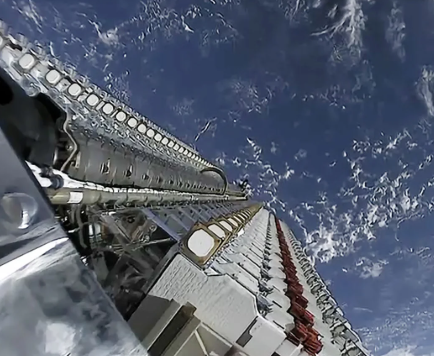Record-Breaking Launch Milestone
On August 18, 2025, SpaceX achieved a major milestone by launching its 100th Falcon 9 mission of the year, carrying 24 Starlink satellites into orbit from Vandenberg Space Force Base, California SpaceSpaceflight Now. This flight, designated “Starlink 17-5,” marked SpaceX’s 72nd Starlink launch in 2025 alone and brought the annual total of satellites launched to 1,786 Spaceflight Now. The Falcon 9 booster, B1088, successfully landed on the drone ship Of Course I Still Love You, contributing to SpaceX’s growing tally of reusable rocket landings Spaceflight Now.
Direct-to-Cell Technology Breakthrough in Ukraine
In a strategic step toward expanding mobile coverage, Ukraine’s Kyivstar became the first in Eastern Europe to test Starlink’s Direct-to-Cell technology. The successful trial in the Zhytomyr region enabled regular smartphones to exchange messages via satellite—functioning akin to orbiting cell towers. Commercial rollout of messaging services is slated for late 2025, with full mobile broadband expected in early 2026 Reuters. This innovation holds transformative potential for connectivity in conflict zones and remote locations.
Pushback Against Fiber Funding in Virginia
SpaceX has publicly criticized the state government of Virginia for allocating broadband funding toward fiber infrastructure. The company argues this approach undercuts the benefits of satellite-based internet and is lobbying to shift focus toward Starlink-based solutions Data Center Dynamics.
Standby Mode Replaces Pause Feature for Starlink Mini
A policy shift affecting portability: Starlink Mini users have lost the previous “pause” option. It has been replaced by a $5 monthly “Standby Mode,” which offers limited (0.5 Mbps) service for occasional use. This change has been seen as eroding the value proposition for infrequent users, prompting criticism and raising hopes that competitors like Amazon’s Kuiper may offer better alternatives The Verge.
Expanding Access in South Africa and the Philippines
- In South Africa, Starlink is seeking “harmonization” to bypass the country’s 30% local-ownership requirement. The move reflects increasing regulatory negotiations to facilitate entry into new markets Stuff South Africa.
- In the Philippines, the crypto exchange Bitget has partnered with Starlink to extend its PayFi Islands initiative to Negros Oriental. Starlink connectivity is being deployed at Apo Elementary School and the Arts and Design Collective in Dumaguete, enhancing educational and creative community infrastructure in underserved areas
Also visit:-
Starlink: Revolutionizing the Future of Internet Connectivity in 2025

In the modern digital era, access to the internet is no longer a luxury—it is a necessity. From education to healthcare, from entertainment to commerce, reliable internet plays a critical role in almost every aspect of our lives. Yet, billions of people across the world still live in areas where high-speed internet remains inaccessible or extremely expensive. This is the gap that Starlink, a satellite-based internet service powered by SpaceX, aims to fill.
Starlink’s mission is bold yet simple: deliver fast, low-latency, and affordable internet anywhere on Earth—whether you are in the middle of a dense city, a remote mountain village, or out at sea. By using thousands of satellites in low Earth orbit (LEO), Starlink bypasses the limitations of terrestrial internet infrastructure like fiber cables or cell towers.
In this blog, we will dive deep into Starlink’s history, technology, availability, benefits, challenges, competitors, and its future impact on global connectivity. By the end, you will understand why Starlink is not just another internet provider, but a potential game-changer in the world of communication technology.
History and Evolution of Starlink
The Early Days
The idea of satellite internet is not new. As early as the 1990s, companies like Iridium and Teledesic attempted to build global satellite communication networks. However, these early projects failed due to high costs, technological limitations, and low demand. The world simply was not ready for satellite internet at that time.
Fast forward to the 2010s, when internet demand skyrocketed globally, and Elon Musk’s SpaceX took up the challenge. SpaceX envisioned a megaconstellation of satellites orbiting close to Earth, providing high-speed coverage across the globe. In 2015, Starlink was officially announced, and development of prototype satellites began.
First Launches
In May 2019, SpaceX launched its first 60 operational Starlink satellites aboard a Falcon 9 rocket. While these launches initially raised concerns among astronomers about light pollution, they marked the beginning of a massive revolution in internet infrastructure.
By the end of 2020, Starlink had entered public beta testing under the tagline “Better Than Nothing Beta.” Early users reported speeds between 50 Mbps and 150 Mbps—far better than what many rural ISPs offered.
Expansion
Since 2019, SpaceX has launched thousands of satellites. By mid-2025, over 7,600 Starlink satellites are active, making up nearly two-thirds of all Earth’s active satellites. This aggressive expansion ensures continuous improvement in coverage, capacity, and speed.
How Starlink Works: Technology Explained

Low Earth Orbit Satellites
Unlike traditional satellites that orbit at 36,000 km, Starlink satellites orbit between 340 km and 550 km above Earth. This proximity reduces latency (the time data takes to travel) to as low as 20-40 milliseconds, making Starlink suitable for online gaming, video conferencing, and other real-time applications.
The User Terminal
Subscribers receive a Starlink dish (often called “Dishy”) and a Wi-Fi router. The dish automatically aligns itself with satellites overhead, eliminating the need for manual setup. Starlink has also introduced smaller, portable dishes like the Starlink Mini, which allow users to carry internet access anywhere.
Laser Inter-Satellite Links
The latest generation of Starlink satellites includes laser links, allowing satellites to communicate directly with each other without relying on ground stations. This technology reduces dependence on local infrastructure and extends coverage to oceans, deserts, and remote regions.
Direct-to-Cell Technology
In 2025, Starlink successfully tested Direct-to-Cell technology with telecom partners. This breakthrough allows regular smartphones to connect directly to satellites without any special hardware. Imagine sending a text message or browsing the internet in the middle of a desert or forest without a mobile tower—this is the future Starlink is building.
Global Availability of Starlink
Starlink is now available in over 110 countries, including the United States, Canada, most of Europe, Australia, Japan, and parts of South America and Africa. In many of these regions, Starlink has become a lifeline for communities with no access to fiber broadband.
For example:
- In rural Canada, farmers use Starlink to connect smart farming equipment.
- In Australia, outback communities finally enjoy video calls and e-learning.
- In Alaska, Starlink provides connectivity where laying fiber was impossible due to harsh geography.
In addition, airlines like United Airlines and Qatar Airways, as well as shipping companies, have begun using Starlink Aviation and Maritime packages to provide high-speed internet during flights and voyages.
Starlink in India
India, with its massive population and growing digital economy, is a crucial market for Starlink. In 2025, Starlink received provisional regulatory approval and signed partnerships with Reliance Jio and Bharti Airtel for potential collaboration.
Challenges in India
- Pricing: Starlink kits cost $400–$600 (₹35,000–₹50,000), which is far higher than average Indian broadband plans.
- Regulation: India’s telecom regulations are strict, requiring local data centers and spectrum licenses.
- Competition: Companies like JioSat, Airtel-OneWeb, and BSNL-Skylo are also entering the satellite internet space.
Opportunities in India
Despite challenges, Starlink could revolutionize rural internet in India:
- Empowering digital classrooms in remote villages.
- Providing telemedicine in rural clinics.
- Supporting agriculture with smart IoT devices.
- Enabling e-commerce in underserved regions.
If Starlink successfully addresses pricing and regulatory issues, it could connect millions of Indians who remain unconnected.
Benefits and Use Cases of Starlink

- Rural Connectivity – Bringing high-speed internet to villages and farms.
- Disaster Relief – Starlink dishes can restore communication quickly after natural disasters like earthquakes, floods, or hurricanes.
- Military & Emergency Use – Starlink has been crucial in Ukraine’s defense, maintaining secure communication during conflicts.
- Education – Students in remote areas gain access to e-learning resources.
- Business Expansion – Remote businesses can now operate globally with reliable internet.
- Travel & Adventure – Starlink Mini enables adventurers, campers, and truck drivers to stay connected anywhere.
Challenges and Competitors
Challenges Facing Starlink
- High Costs: Equipment and subscription prices are steep for many users.
- Space Debris: Thousands of satellites raise concerns about collisions in space.
- Light Pollution: Astronomers complain that satellites interfere with telescopic observations.
- Service Outages: Global outages have occasionally disrupted service.
Competitors
- OneWeb (backed by Airtel and UK government).
- Amazon’s Project Kuiper (aiming to launch thousands of satellites).
- AST SpaceMobile (focusing on satellite-to-smartphone services).
Competition ensures better pricing, innovation, and global service improvements.
Future of Starlink
The next 5 years are crucial for Starlink. With the development of V3 satellites, direct-to-cell services, and expansion into new markets, Starlink could potentially serve hundreds of millions of users worldwide. Moreover, its synergy with Tesla cars, global aviation, and maritime connectivity will make it a universal internet backbone.
Tesla at a Crossroads: $1T Pay, European Production Push and Autonomous Ambitions — 15 Sept 2025

Pingback: MN Festival of Nations 2026 schedule + Tickets: The No-Fluff Planner - mineVerse360